Gemstones and jewellery are a universal form of adornment and they have been a part of mankind since before history was written. It is likely that from an early date, it was worn as a protection from the dangers of life or as status symbols. However, the jewellery worn in the old days was not made as we make it today.
Ladies and gentleman, let’s get back into our history and let me take you through a ride of evolution jewellery.
1) ANCIENT ERA
The possibility of tracing jewellery’s historic itinerary derives primarily from the custom, beginning with the most remote civilizations, of burying the dead with their richest garments and ornaments. The history of jewellery dates back to prehistoric times when early humans wore shell, bone, wood, pebbles, animal skin and feathers as adornments for bodily decoration for thousands of years.
In the ancient world, the discovery of how to work metals was an important stage in the development of the art of jewellery. Over time, metalworking techniques became more sophisticated and decoration more intricate. Gold, a rare and highly valued material, was buried with the dead to accompany its owner into the afterlife. Much archaeological jewellery comes from tombs and hoards.
The different era of ancient jewellery were Sumerian Jewellery, Egyptian Jewellery, Phoenician Jewelry, Greek Jewelry, Etruscan Jewelry Celtic Jewelry, Roman Jewelry.
Jewels belonging to the Ancient Era

2: Ottonian crown on display at Essen’s cathedral treasury, ca. 1100. Image Credit-Lang Antique & Estate Jewelry.
3: Byzantine Jewelry Link. Image Credit-Lang Antique & Estate Jewelry.

2: Etruscan Woven Necklace with Festoon Suspended Pendants and Scarabs c.500 BC. Image Credit-Lang Antique & Estate Jewelry.
3: Phoenician jewellery found in Kition. Image Credit-Lang Antique & Estate Jewelry.
2) MEDIEVAL ERA: 5th-15th century
This was a time of extreme deprivation and suffering for most of Western Europe’s population because of the effects of famine, wars and the plague. Many people had to fight for their lives daily and the advancement of knowledge, technology and art came almost to a standstill. The jewellery worn in this period reflected an intensely hierarchical and status-conscious society. Royalty and the nobility wore gold, silver and precious gems. Lower ranks of society wore base metals, such as copper.
The features of the jewellery during this Era are:
– Personal adornments, decorations for weapons along with necklaces, bracelets and brooches. The rich made small embellishments of jewellery sewn into their garments.
– Gold was the main material used with different techniques used to decorate metal such as enamelling, plating and gilding, soldering, inlay and casting.
– Gemstones commonly used were freshwater pearls, amber, jet and coral, which were found within Europe; whereas other gemstones like emeralds and rubies had to be imported.
– Gems were cut and polished into cabochons with rounded edges because facet-cut gems were difficult to create.
Jewels belonging to the Medieval Era

2: Shoulder clasp dating back to the early 7th century. Image Credit-Lang Antique & Estate Jewelry.

2: Imperial Glove in Schatzkammer in Wien (Austria). Made in Palermo before 1220. Image Credit-Lang Antique & Estate Jewelry.
3: Clasp-reliquary with an Eagle made the middle of 14th century. Image Credit-Lang Antique & Estate Jewelry.
These are an outstanding example of the craftsmanship that went into jewellery making at that time.
3) RENAISSANCE ERA: Half-way through the 15th-century
The term “Renaissance” means “rebirth” and quite aptly sums up this period, for it was an important time of social and cultural change. The Renaissance itself started after the Middle Ages in 14th century Italy and the centuries following, it spread throughout Europe. New continents were discovered during this period and along with them came the expansion of trade and ultimately an increase in wealth also known for great developments in art and culture.
In terms of the history of jewellery, the Renaissance played an important part in its transformation.
The features of the jewellery during this Era are:
– Items of jewellery gradually evolved from the brooches and shoulder clasps of the Medieval Ages to more modern items like necklaces, chandelier, earrings and bejewelled headdresses.
– Probably the most iconic item of jewellery from the Renaissance period was the pendant, worn on a necklace. Pendants were often enamelled on the front and back.
– A range of gemstones like emeralds, rubies, diamonds, topaz, amazonite, garnet, amethyst and many more were available. Pearls, especially Baroque Pearls were very popular and featured in many jewellery designs.
Jewels belonging to the Renaissance Era.

2: Designs for Pendant Jewels by Hans Holbein. Image Credit-Lang Antique & Estate Jewelry.
3: Renaissance Decorated Object. Image Credit-Lang Antique & Estate Jewelry.
4: Renaissance Necklace. Image Credit-Lang Antique & Estate Jewelry.
Numerous preserved portraits give us a wonderful insight as to the splendor of jewellery back then. Dress jewels started to appear all over the bodice of dresses rather than just on the edges, as had been the fashion in the Middle Age.

Dresses were closed at the neck with high collars and necklaces were worn over the dress and suspended large pendants.
4) BAROQUE JEWELRY ERA start of the 17th century
Renaissance jewellery evolved gradually into a new style. The rigid and contorted dresses that had been worn by the ladies of the Renaissance were less preferred over soft flowing dresses, and new jewellery was created to go with the new fashion.
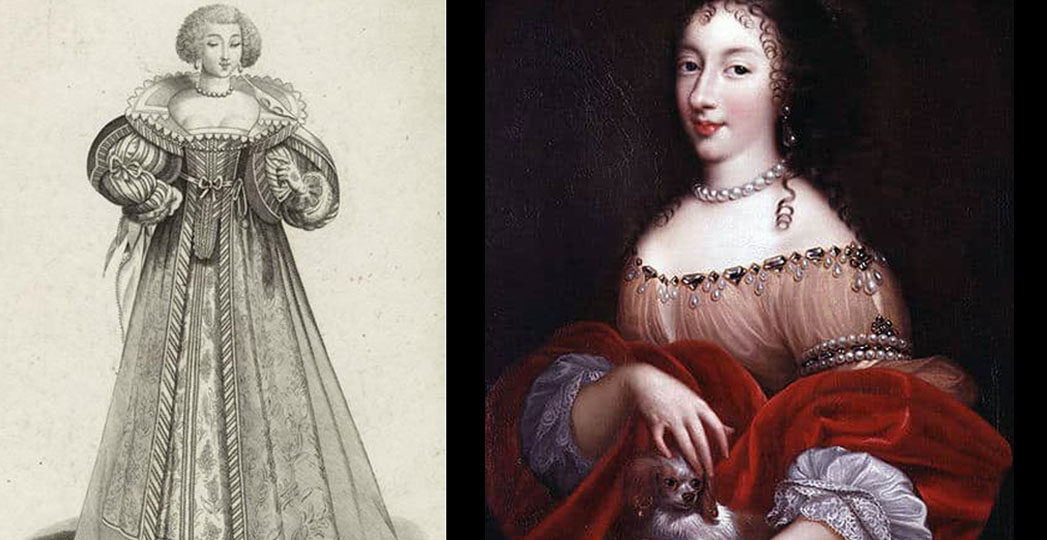
The features of the jewellery during this Era are:
– ‘Cosse de pois’ (pea pod) shapes and later flowers became very popular and over the 3rd and 4th decade many designs in this fashion were produced.
– The second half of the 17th century saw the importance of faceted gemstones in designs. Gem mountings became more delicate and the designs moved away from cluster settings to naturalism and ribbon bow.
– By the end of the 17th century, asymmetrical bouquets or individual flowers prevailed and the use of enamel diminished to the point that it was only to be found in the most conservative circles. The Rococo style which was mainly functional jewellery like chatelaines and snuff boxes gained popularity.
– Diamonds, pearls, ruby, emerald and topaz were among the most prized species. High-quality imitation jewellery with strass (paste) was being produced on a large scale to meet the increased demand of the growing bourgeoisie.
– A new development during the era was the watch, techniques were unleashed to turn watch cases into the most astonishing jewellery items of their day.
Jewels belonging to the Baroque Era.

2: Bow brooch design 17th century. Image Credit-Lang Antique & Estate Jewelry.
3: Oval Silver Cased Verge Watch with Date Indicator. 1670-1680. Image Credit-Lang Antique & Estate Jewelry.
5) THE GEORGIAN ERA (1714 – 1837)
Starting with the 18th century, we go through history’s most important periods of jewellery styles. This era lasted for over 100 years and spanned four English Kings: King George I, King George II, King George III, and King George IV. Jewellery was to be worn only by the aristocracy as part of the laws, however, as the era developed it became acceptable for the emerging middle class to were items of elegance as well.
The features of the jewellery during this Era are:
– Metals commonly used in jewellery during the period included silver, gold, steel, iron, and pinchbeck.
– The common metalworking techniques were Repoussé, which involved hammering malleable metal into intricate designs; and; Cannetille a metalworking technique, which involved intricate wirework designs, resembling embroidery-inspired filigree.

2: Georgian Mourning bracelet. Image Credit-Lang Antique & Estate Jewelry.
3: Natural pearl brooch c 1820 featuring 6-7 separate locks of hair coil. Image Credit-Lang Antique & Estate Jewelry.
– Since metal casting wasn’t used, hand carving was the common method of producing jewels.
– Gemstones included were topaz, garnet, emerald, ruby, coral, pearls along with Diamonds such as point-cuts, table cuts, Old Mine cuts, cushion cuts, single cuts, and rose-cut and simulated stones such as paste as a cheaper alternative for a diamond effect.
– Settings were almost exclusively silver foil or yellow gold. This was to enhance the light properties of the stones.

2: Diamond devant de corsage. Image Credit-Lang Antique & Estate Jewelry.
3: Colombian emerald, old mine cut and natural diamond necklace and earrings. Image Credit-Lang Antique & Estate Jewelry.
The most popular jewels in the Georgian era are Girandole Pendeloque earrings, Cameos
Parure, Portrait miniatures, Hair jewellery, just to name a few.
6) THE VICTORIAN ERA (1837 – 1901)
The Victorian Era is a reference to Queen Victoria of England, she reigned during this time and was responsible for much of the great changes in the jewellery. Jewellery from the Victorian Era is far more prevalent than during the Georgian Era and easier to find.
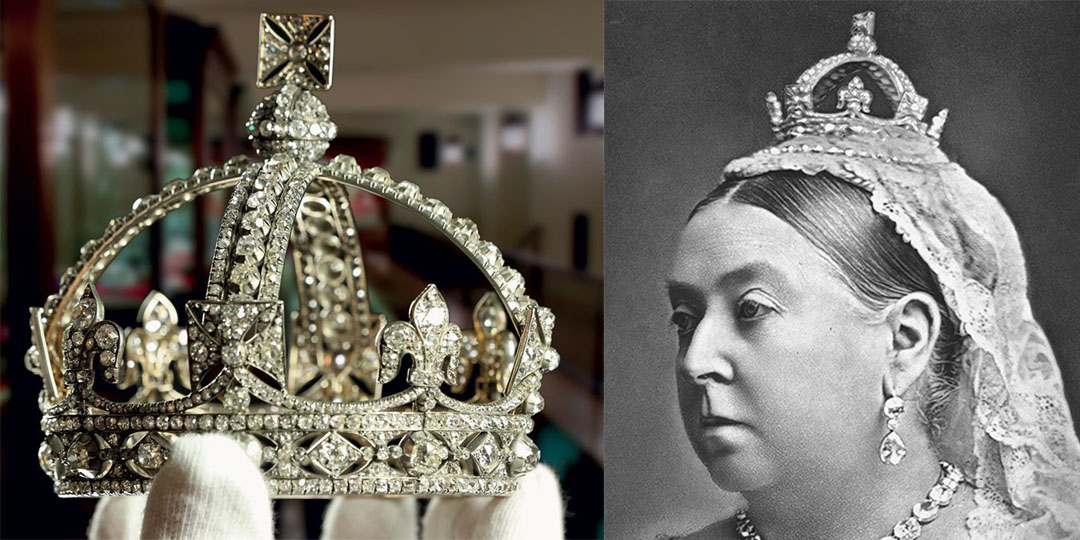
The features of the jewellery during this Era are:
– Gold and silver remained the most popular metals in Victorian Era engagement rings and other pieces.
– Stones popular during this time were garnets, amethyst, turquoise, sapphires, pearls, and diamonds.
– Motifs involving animals, especially snakes were very popular.
The era itself splits into three periods. Each of these three stages correlates to the different periods of Queen Victoria’s life.
The Romantic Victorian Period: 1837-1860.
This period was one of joy, new beginnings and positive growth for Victoria. The floral motifs, brightly coloured gemstones, and glistening gold filigree mirrored the love and good fortune shared between Victoria and Albert, and the economic growth of the British Empire. Soon after, snake motifs began popping up in necklaces, pins and other jewellery.
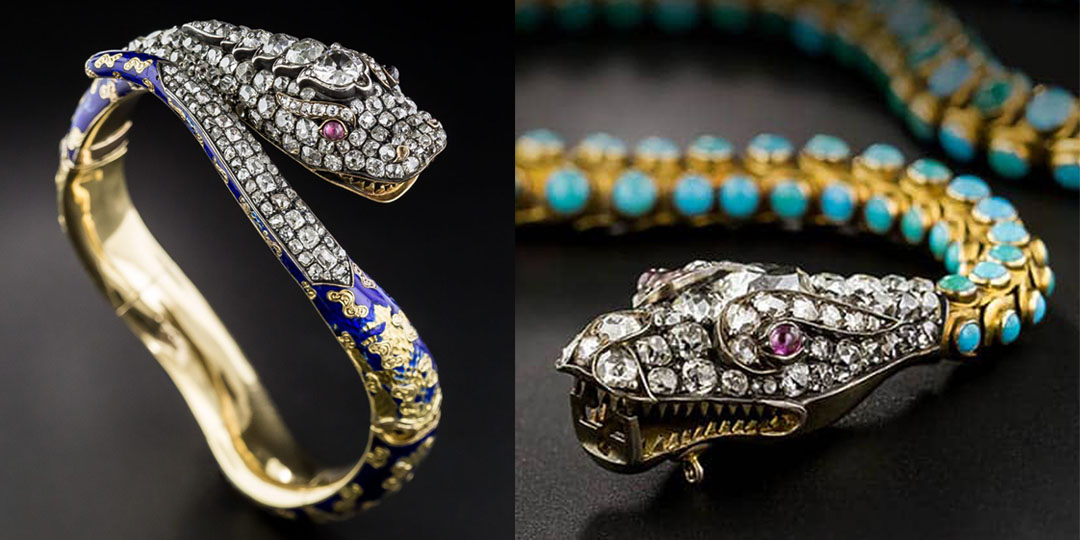
2: Victorian Snake jewellery. Image Credit-Lang Antique & Estate Jewelry.
The Grand Victorian Period (1861-1880)
However, following Prince Albert’s death in 1861 and the Queen’s adoption of mourning garb, all-black mourning jewellery became popular. Jewellery from Grand Period was made of jet, onyx, and black glass. Human hair was also incorporated into designs; as a sentimental tribute. But darker and foreboding motifs like skulls and skeletons were frequently added to jewellery designs. During this time, cameos grew in popularity as a way to remember or honor a loved one.
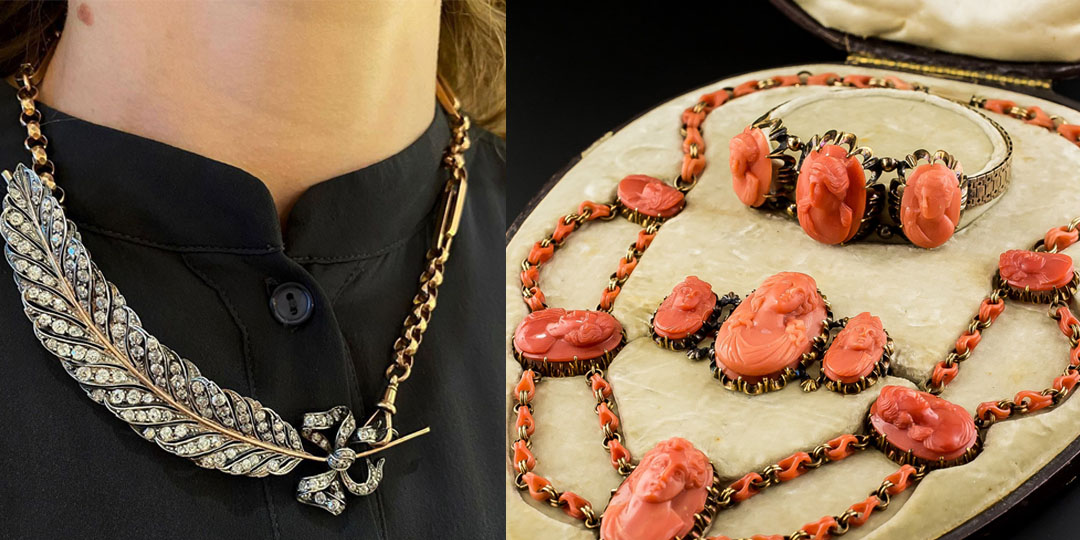
2: Victorian Coral Cameo Jewelry Suite of Necklace, Brooch and Bracelet. Image Credit-Lang Antique & Estate Jewelry.
The AestheticVictorian Period (1880-1901).
Social changes also influenced the jewellery of this age. Victoria’s son, Edward’s wife, Alexandra, popularized the iconic Victorian choker necklace. The huge boom in wealth meant that even workers had leisure time, and fashion for entertainments became important trademarks of Victorian style. Women enjoyed unprecedented levels of independence. Victorian jewellery was replaced by smaller pieces to accommodate the changing times, jewellery was overall smaller and lighter. Common motifs of the Aesthetic Movement included peacocks, flowers, insects and Japanese-inspired forms.
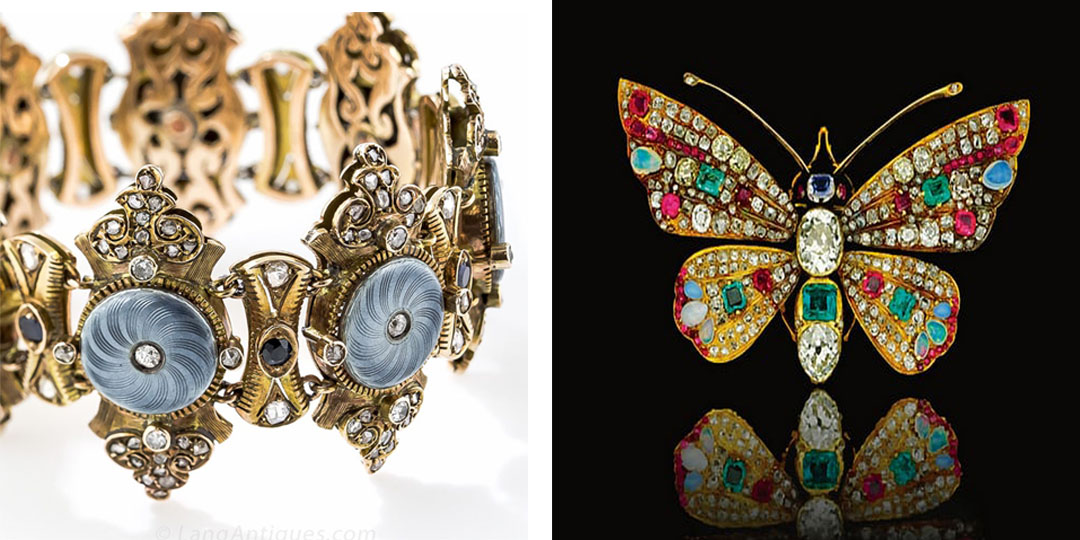
2: Victorian Butterfly Brooch. Image Credit-Lang Antique & Estate Jewelry.
Isn’t there anything that is as royal and classy as the Victorian Jewelry??
7) THE EDWARDIAN ERA (1901-1915)
The Edwardian Era follows the reign of England’s King Edward, he was the last monarch to serve as a namesake in jewellery history.
The features of the jewellery during this Era are:
-This period, also known as “LA BELLE EPOQUE ERA”, is the first time platinum was officially a part of the jewellery scene. Although platinum was first crafted together with gold, it very quickly grew in popularity and was later an item of its own.

2: Belle Epoque Brooch. Image Credit-Christies Jewels.
3: Alternative styling of Belle Époque articulated diamond collar necklace. Image Credit-Lang Antique & Estate Jewelry.
4: Belle Epoque diamonds and Turquoise Corsage. Image Credit-Christies Jewels.
– Diamonds and pearls retain their prestigious status during this period.
– Compared to those of the Victorian Era, Edwardian engagement rings and other pieces from the Edwardian Era are ornate, intricate, and flowery. -Contributing to this style are the techniques of openwork filigree and fine milgrain introduced during the Edwardian times.
– Diamond “dog collars” became a fashion fixture in France c.1865, catching on in England c.1880, they were a favourite of the Princess of Wales. These tight-fitting necklaces ranged from elaborately pierced platinum gossamer designs in the garland motif to simple black velvet or moiré ribbons with buckles, flowers and other designs at the centre.
– Advancements in technology gave jewellers new ways to utilize platinum.

2: Parme Tiara c.1915 is Emblematic of the House of Chaumet. Image Credit-Lang Antique & Estate Jewelry.
3: Edwardian Diamond Pearl Sautoir. Image Credit-Lang Antique & Estate Jewelry.
This Era is so femine, classy with very intricate detailing.
8) ART NOUVEAU (1890 – 1910)
Now moving on to The Art Nouveau period, which was named after the 1895 opening of Siegfried Bing’s Parisian gallery “Maison de l’Art Nouveau”. The natural aspect of Art Nouveau was very appealing to a society that was becoming more aware of decorative quality. By the end of the 19th century, the style had begun to spread globally and became one of the most important style periods in history.
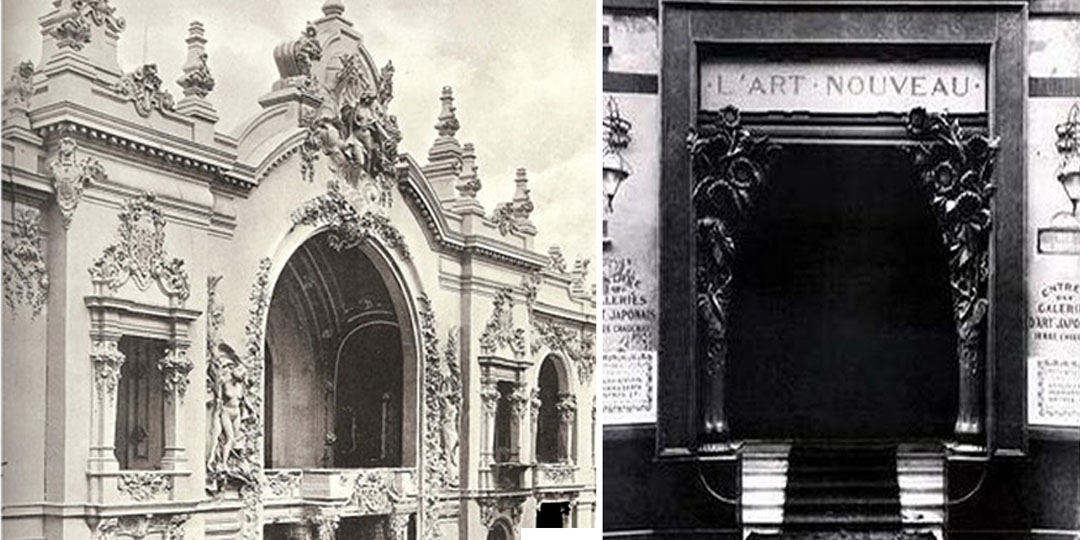
The features of the jewellery during this Era are:
– Art Nouveau jewellery is a celebration of free form, it contains an organic structure with no symmetry.
– Various themes and motifs were recurrent in Art Nouveau jewellery such as Insects, especially dragonflies and butterflies.
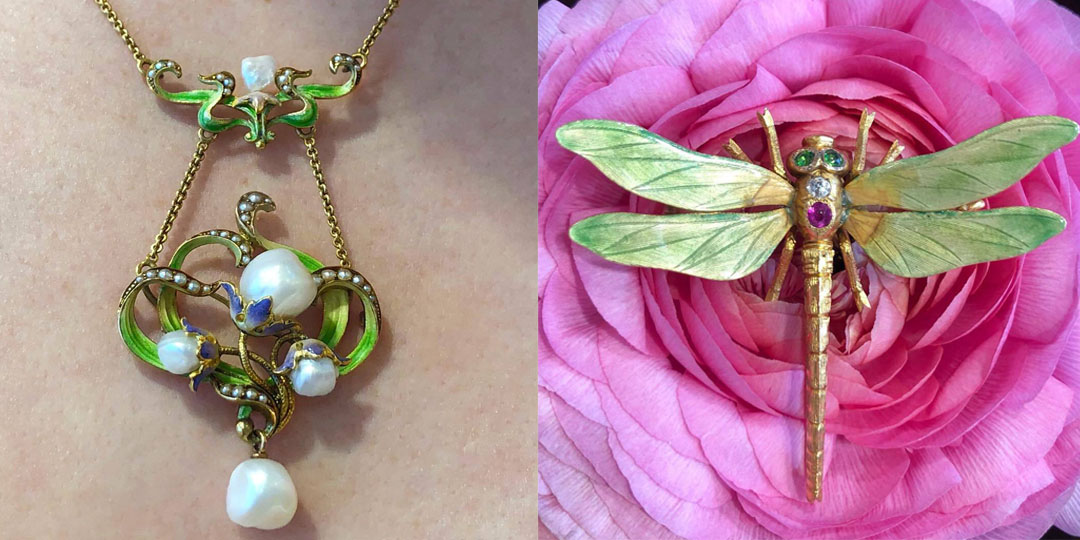
2: Rene Lalique Plique à Jour Dragonfly brooch. Image Credit-Lang Antique & Estate Jewelry.
– Enamel was one speciality that became characteristic of Art Nouveau jewellery, Plique-à-jour enamel was particularly suited to provide colour, light, and life to the gossamer wings of these fascinating creatures.
– Champlevé enamel was masterfully applied in new ways to add depth and mystery.
– Pâte de Verre, a kind of glass that could be manipulated to a gem-like appearance, could be shaped and polished into all manner of objects and was used extensively throughout this period.
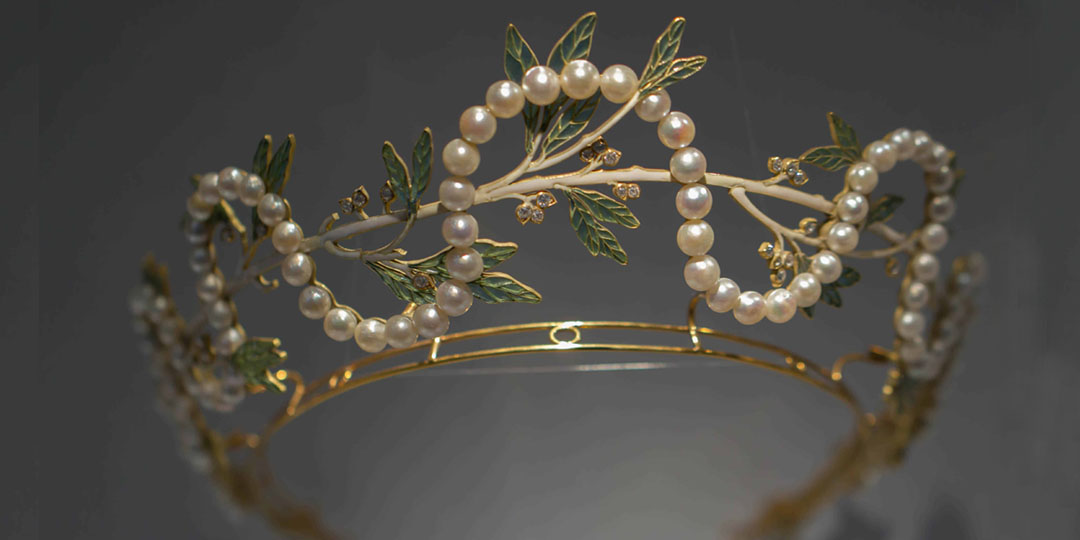
One of the most influential designers working in the Art Nouveau style was René Lalique (1860-1945), he sold designs to the great jewellery houses of the period.
By the end of the 19th century, the style had begun to spread globally and became one of the most important style periods in history. The Art Nouveau movement drew to a close with the onset of war in Europe. The style was not picked up again until after the war, Genuine Art Nouveau jewellery from the early 1900s is very difficult to find.
9) ART DECO (1920 – 1945)
Art Deco pieces are known for being geometrical, angular, and clean. The Art Deco style inspired many architects to design landmarks using these concepts.

The Art Deco period emerged after the conclusion of World War I, It took its name, short for Arts Décoratifs, from the Exposition Internationale des arts décoratifs et industriels modernes (International Exhibition of Modern Decorative and Industrial Arts) held in Paris in 1925. It combined modernist styles with fine craftsmanship and rich materials. During its heyday, Art Deco represented luxury, glamour, exuberance, and faith in social and technological progress.

The features of the jewellery during this Era are:
– Platinum was the primary metal of the Art Deco
– Geometry was suddenly the “in” word. Not just on the drawing boards of architects, but also of jewellery designers, triangles, squares, polygons, and even more complex shapes were used in jewellery of all types, with contrasting colour such as black and white.
– Lines are usually everywhere in the design.
– The diamonds, sapphire, rubies, onyx, and emeralds helped assert the bold and prominent aesthetics of the Art Deco period.
– New York, as an example, has many iconic buildings that just ooze Art Deco style and bravado. The Empire State Building, the Chrysler Building, Rockefeller Center and The New Yorker hotel are all classic Art Deco designs.

2: Art Deco bangles. Image Credit-Lang Antique & Estate Jewelry.
3: Art Deco sautoir Necklace. Image Credit-Lang Antique & Estate Jewelry.
4. Collage of Art Deco jewels. Image Credit-Pinterest
Unlike many design periods, Art Deco came but then never really went away again.
RETRO (1939 – 1950)
Let’s get Bold and Beautiful!
The Retro period concluded with the end of World War II. The style is heavily inspired by the war and the victory that followed.
During the Retro period yellow gold overtook the production of white gold and platinum in the jewellery industry, as Platinum and the alloys used to create white gold were needed to make weapons, hence the manufacturers were not allowed to purchase these metals during World War II.

2: Ballerina Brooch and Matching Earrings. Image Credit-Lang Antique & Estate Jewelry.
3: Women’s Fashions Took a Masculine Turn During the war years. Image Credit-Lang Antique & Estate Jewelry.
The features of the jewellery during this Era are:
– The designs were chunky, futuristic, they lacked gemstones due to wartime shortages and supplies of real gemstones from Asia were cut-off during World War II.
– The settings popular during this time were the illusion settings and the settings in which the metal around a diamond was cut and polished to make the diamond appear larger than it was.
– Retro pieces resembled the geometric jewellery of 1920’s Art Deco period, but Retro pieces were three-dimensional, not flat.
– Due to wartime scarcity, Retro Jewels weren’t adorned from top to bottom with gems like Art Deco jewellery.

First designed in 1934, Van Cleef & Arpels ‘Ludo’ style is a reference to “Louis Arpels” nickname. Usually set with rubies, sapphires or diamonds in a star setting, the articulated ribbon is often in yellow gold but sometimes in platinum. The clasp also varies depending on the model; either designed as a buckle motif set with diamonds, or as a stylized bridge encrusted with rubies or sapphires in a Mystery setting.
These bold, modern pieces went well with the masculine wartime fashions of famous designers Coco Chanel and Elsa Schiaparelli.
Fifties Jewellery
So here me winding up Evolution of jewellery series with 1950’s Jewelry.
After the war years, the world was ready for flamboyant displays of gems and jewellery.
The world of haute couture sought to celebrate the feminine figure, and with the jewellery the phrase “the more the merrier” seemed popular. DeBeers Diamond Corporation launched its marketing campaign ‘A Diamond is Forever’ to promote diamonds to every income level, especially the rapidly growing middle class.

The features of the jewellery during this Era are:
– Gold jewellery retained its popularity but with a twist, a tassel or a texture.
– Ribbons and bows, flowers and leaves, popular in the 40s, were being rendered in the new more textural style.
– Jewellery was more refined than that of the 40s big retro styles.

2: Pearl bracelet. Image Credit-Lang Antique & Estate Jewelry.
3: Natural Pearl necklace. Image Credit-F D Gallery.
– Faux pearls were common and multi-strand necklaces were immensely popular.
– Brooches were a wardrobe staple, often being worn in groups on the shoulder.
– Gold-tone pieces such as wide bracelets and big button earrings were worn as daytime jewellery and the “diamond look” was often seen in the evenings.

2: Fifties Fringe Necklace. Image Credit-Lang Antique & Estate Jewelry.
3: Diamond necklace forming bracelet, circa 1950by VanCleef Arpel. Image Credit-Christies Jewels.
– Sets of matching pieces completed the modern women’s look along with chokers clinging to the base of the neck perfectly complimented the open necklines of mid-century fashion.
As post-war incomes increased and women desired more choice in their accessories,in the 1950s, costume jewellery enjoyed a global boom, perfectly facilitated the trend for women to look well-groomed with clean, colourful, ornate jewellery complimenting to the outfit.
History has no end and it only keeps getting interesting as we delve deeper.
Is there anything more interesting than delving into how your favourite things came into being? Well, this is what this series is about. Hope you all enjoyed reading it, as much as, I did to curate it!
Content and Image credit Lang Antique & Estate Jewelry, Victoria and Albert Museum, British Museum, Yates Jewellers, Golden Age Beads, Estate Diamond Jewelry. Christies Jewels. Wikipedia, Pinterest.

First-rate post I tend to be of the same opinion with nearly all of what you wrote. I would love to see new posts on this. I will bookmark and come back. http://www.piano.m106.com